

Wendy Tremayne. After a fun and fairly meaningless four years of college in New York I meandered through the creative world with stints at book and magazine publishers and in the music business.
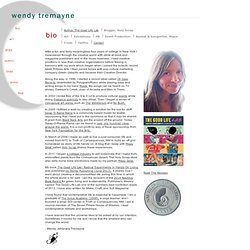
I held creative positions in less than creative organizations before feeling in harmony with my work which began when I joined the eclectic record label, Ellipsis Arts. I then joined forces with pop-culture marketing company Green Galactic and became their Creative Director. Along the way, in 1996, I started a record label called 28 Days Records (distributed by Polygram/Ryko) while playing bass and writing songs in my band Moxie.
My songs can be heard on TV shows, Dawson's Creek, Joan of Arcadia and Men in Trees. In 2002 I broke free of the 9 to 5 rut to produce cultural events while doing freelance publicity to stay afloat. Slow Fashioned. One constant thing about fashion is change.
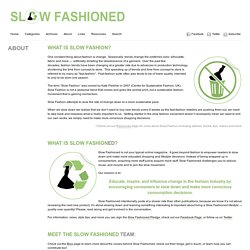
Seasonally, trends change the preferred color, silhouette, fabric and more — artificially dictating the obsolescence of a garment. Over the past few decades, fashion trends have been changing at a greater rate due to advances in production technology, shortening the time from concept to store. This speeding up of trends and time from concept to store is referred to by many as “fast-fashion”. Fast-fashion quite often also tends to be of lower quality, intended to only to be worn one season.
What is Slow Fashion? The Slow Fashion Movement: 10 Brands That Are Doing it Right. December is an important month for the fashion and retail industry--and not just because of the ka-ching of the cash register duing holiday sales.
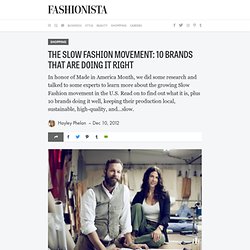
You may not know it, but December is also 'Made in America' month. Started in 1985 under Ronald Reagan, Made in America month aims to encourage consumers to purchase items produced locally in the United States. 'Slow fashion' is a must-have ... and not just for this season. The credit crunch has put paid to high times on the high street, but retailers are reporting the rise of 'slow fashion' as consumers think harder about what they buy.
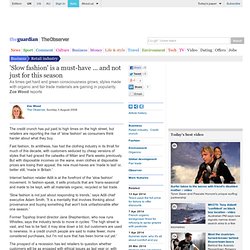
Fast fashion, its antithesis, has had the clothing industry in its thrall for much of this decade, with customers seduced by cheap versions of styles that had graced the catwalks of Milan and Paris weeks previously. But with disposable incomes on the wane, even clothes at disposable prices are losing their appeal; the new must-haves are 'made to last' or, better still, 'made in Britain.' Internet fashion retailer Adili is at the forefront of the 'slow fashion' movement. In fashion-speak, it sells products that are 'trans-seasonal' and made to be kept, with all materials organic, recycled or fair trade.
Where is Sustainable Fashion Headed in 2014? In the face of both triumph and tragedy, fashion’s masked and intricate supply chain is becoming more transparent.
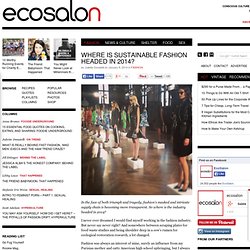
So where is the industry headed in 2014? Slow fashion forward. New fashion consumers realize the powerful role they play in the industry.
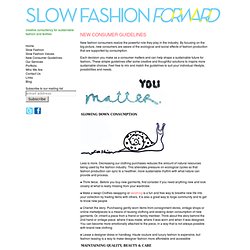
By focusing on the big picture, new consumers are aware of the ecological and social effects of fashion production that are supported by consumption. Each decision you make as a consumer matters and can help shape a sustainable future for fashion. These simple guidelines offer some creative and thoughtful solutions to inspire more sustainable choices. Feel free to mix and match the guidelines to suit your individual lifestyle, possibilities and needs. Less is more. . ● Think twice. . ● Make a swap! ● Cherish the story. . ● Lease a designer dress or handbag. New consumers are encouraged to build a wardrobe of well-made, beautiful and versatile pieces. .
● Quality matters. . ● Support craftsmanship and seek out unique, handmade pieces. Slow Fashion Consultancy. For over a decade businesses, education establishments, arts organisations and the research community, primarily in the fashion and textile sector have been commissioning consultancy services from me.
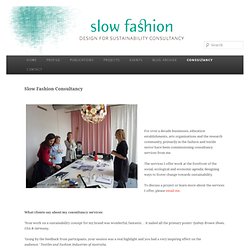
The services I offer work at the forefront of the social, ecological and economic agenda; designing ways to foster change towards sustainability. To discuss a project or learn more about the services I offer, please email me. What clients say about my consultancy services: ‘Your work on a sustainability concept for my brand was wonderful, fantastic… it nailed all the primary points’ Sydney Brown Shoes, USA & Germany. ‘Going by the feedback from participants, your session was a real highlight and you had a very inspiring effect on the audience.’ ‘I cannot thank you enough for this report. Eco-fashion, green design, sustainable style. Schoeller Technologies AG. Die Blätter bestimmter Pflanzen bleiben immer sauber, weil Schmutz auf ihren fein strukturierten Oberflächen nicht haften bleibt.
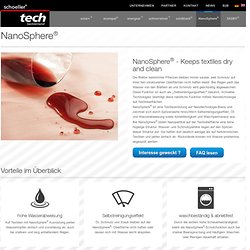
Bei Regen perlt das Wasser von den Blättern ab und Schmutz wird gleichzeitig abgewaschen. Diese Funktion ist auch als „Selbstreinigungseffekt“ bekannt. Schoeller Technologies überträgt diese natürliche Funktion mittels Nanotechnologie auf Textiloberflächen. NanoSphere® ist eine Textilausrüstung auf Nanotechnologie-Basis und zeichnet sich durch Spitzenwerte hinsichtlich Selbstreinigungseffekt, Öl- und Wasserabweisung sowie Abriebfestigkeit und Waschpermanenz aus. Bei NanoSphere® bilden Nanopartikel auf der Textiloberfläche eine feine hügelige Struktur. Die klassische Textiloberfläche (links) Die Kontaktfläche eines Wassertropfens oder von Schmutzpartikeln mit dem Textil, und damit die Haftung, ist sehr gross.
Uniform Project. MAQUILA REGION 4. Atelier ANGEL CHANG.